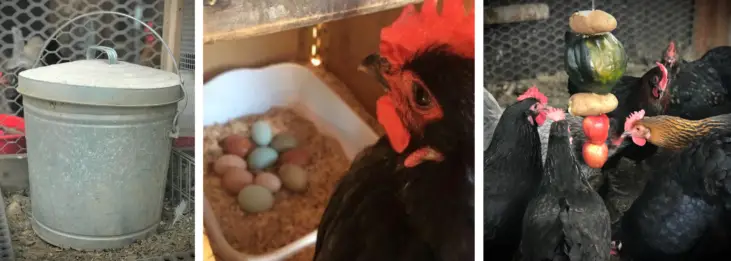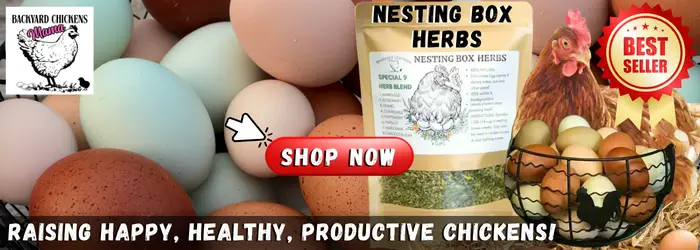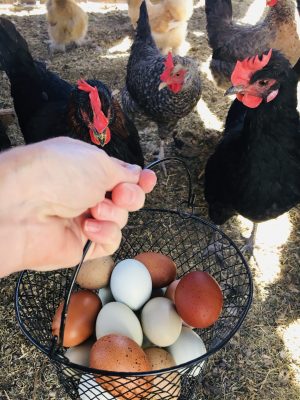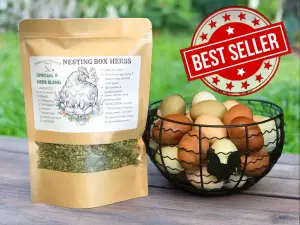
Everyone wants their chickens to be happy and most will do what it takes to make sure that they are. It doesn’t really take much to satisfy them. It’s really just about knowing what they need. By providing your flock with the most important chicken supplies, you will make them very happy and well adjusted.
1. Metal Garbage Can With Secure Lock for Chicken Feed
Predators such as rats, mice, opossums, raccoons are common predators that will easily make their way into a chicken coop to get to any leftovers. They can chew holes through food bags and even plastic food storage containers. Instead, store chicken feed in a metal garbage can with secure lock.

Raccoons are pretty skilled at opening containers, gate locks and latches. So make sure that you secure all feed in a container with a two step locking system. In the photo of the garbage can above, the handle must be pulled up and out to the side simultaneously.
2. Predator Proof Chicken Coop
| PREDATOR PROOF CHICKEN COOP |
|---|
| LOCK CHICKENS UP AT NIGHT |
| INSTALL HAWK NETTING |
| INSTALL ELECTRIC FENCING |
| INSTALL VIDEO CAMERAS |
| 2 STEP LOCKS FOR GATES |
| COLLECT EGGS BEFORE DUSK |
| INSTALL 1/4″ HARDWARE CLOTH |
| GUARD DOGS |
| CLEAN UP UNEATEN FOOD |
| STORE FOOD IN LOCKED, METAL CONTAINERS |
Chickens that feel safe, protected from predators, experience less stress and are happier chickens!
Enclosing chicken feed in a predator proof, metal garbage can with lid is the start of making sure your flock is protected against predator attacks.
Install 1/4″ hardware cloth around the perimeter of your coop to stop predators from getting in. Chicken wire will only protect your chickens from getting out, not predators from getting in.

To stop predators from digging under to get into the coop, dig a trench 1′ deep around the perimeter and attach 1/4″ hardware cloth.
For additional security consider installing a mow strip, adding pavers or bricks around the perimeter.
Install hawk netting over chicken run, install video cameras and electric fencing, use 2 step-locks for gates, collect eggs before dusk and make sure that all your chickens are in at night.
For additional information on how to protect your chickens, read my article, 9 Simple Tips – How to Protect Your Chickens.
3. Large Chicken Waterers with Fresh Water

Chickens should always have access to fresh water. The average size adult chicken will drink a pint of water a day and on a very hot day up to a quart of water a day. If they are not provided with enough water, they will become stressed, unhappy, and stop laying eggs.
On hot days, consider replenishing your flocks water more than one time. Have more than one source of water available, just in case one gets dumped over. You can even add ice cubes to the water to keep it cool.
For more information on how to keep your chickens cool, read my article, 17 Tips – How to Keep Chickens Cool in Extreme Heat.
Adult Laying Hen Water Consumption on Regular Day vs. Hot Day
| # ADULT CHICKENS | AVERAGE WATER / DAY | AVERAGE WATER / HOT DAY |
|---|---|---|
| 4 | 2 QUARTS / 1/2 GALLON | 1 GALLON |
| 6 | 3 QUARTS / 3/4 GALLON | 1.5 GALLONS |
| 8 | 4 QUARTS / 1 GALLON | 2 GALLONS |
| 10 | 5 QUARTS / 1.25 GALLONS | 2.5 GALLONS |
| 12 | 1.5 GALLONS | 3 GALLONS |
| 14 | 1.75 GALLONS | 3.5 GALLONS |
| 16 | 2 GALLONS | 4 GALLONS |
| 18 | 2.25 GALLONS | 4.5 GALLONS |
| 20 | 2.5 GALLONS | 5 GALLONS |
| 30 | 3.75 GALLONS | 7.5 GALLONS |
| 40 | 5 GALLONS | 10 GALLONS |
| 50 | 6.25 GALLONS | 12.5 GALLONS |
4. Proper Size, Location and Number of Nesting Boxes
Laying hens need to be provided the proper size and number of nesting boxes. This nesting box should be in a safe, secure location for her to lay her eggs. By keeping your chickens happy, they will continue to provide you with an ample supply of eggs.

What is the Proper Size Nesting Box for a Chicken?
Nesting boxes for an average size chicken, such as Leghorns, Marans and Ameraucanas, should be 12″L x 12″W x 12″H. For larger breed hens, such as Orpingtons, Giant Cochins and Jersey Giants, 12″ L x 14″ W x 12″ H. They can be slightly smaller for bantam breeds.
If the nesting boxes are too large, more than one hen will try to lay at the same time in the same box. Too many hens in one nesting box can lead to broken eggs.
Where Should Chickens Nesting Boxes be Placed?
Hens prefer a darker, quieter location to lay eggs. Try to place the nesting box area in a location that does not have a lot of foot traffic or noise. This includes a neighbors barking dog. Too much noise and traffic will stress your hens out and decrease the egg production.
How Many Nesting Boxes Do I Need?
It is important to provide enough laying boxes so your hens do not decide to lay eggs elsewhere. On the average, you will need one laying box for every 4 laying hens that you have. Don’t be surprised if all of your hens line up for that one “special” laying box though.
| # LAYING HENS | # NESTING BOXES |
|---|---|
| 1-4 | 1  |
| 5-8 | 2  |
| 9-12 | 3    |
| 13-16 | 4     |
| 17-20 | 5      |
| 21-24 | 6       |
| 25-28 | 7        |
| 29-32 | 8         |
5. Variety of Different Perches for Chickens
Chickens need to perch up high at night in order to feel happy and secure. They are prey animals and by instinct know they need to roost somewhere high to prevent attack by predators.
Provide a roosting perch about 3-4 feet off the ground for chickens to sleep at night. Just make sure that their roosting bars are higher than the nesting boxes. Otherwise you might have chickens sleeping inside their nesting boxes.
A proper size roosting bar will allow your chickens to curl their toes around the bar. They like to sleep with their feet flat, but curl their toes around the perch. A 2″ x 2″ perch, either rounded or square is fine, as long as it is smooth.

Chickens like to huddle close together when they sleep, especially in the cooler winter months, to keep warm. They need about 10″ roosting space per chicken. The bantam breeds, a little less.
Older hens may have difficulty getting to a higher roost and Silkies cannot fly. So, provide a lower perch, so older chickens and Silkies have somewhere to roost at night.
Make sure you provide enough space for all of your chickens to roost at night. If you do not have enough roosting space, chickens will either roost in their nesting boxes or on the coop floor. The coop floor is not very sanitary and it puts them at risk of developing mites, fleas or other parasites.
Don’t throw away old tree branches. Put a nice cut branch in for your chickens to roost on. Your chickens will love to be able to perch up a new tree branch and get a new perspective on their surroundings.
6. Boredom Busters for Happy Chickens

Keeping your chickens entertained will help to decrease boredom and cut down on behavioral issues and fighting within the flock.
By giving your chickens activities to do it also keeps them active. Here are several different boredom buster activities that you can do for your chickens.
| CHICKEN BOREDOM BUSTERS |
|---|
| HANG A FRUIT AND VEGETABLE SKEWER |
| PROVIDE DUST BATHING AREA |
| CHANGE OUT PERCHING AREAS, PROVIDE NEW TREE BRANCHES |
| SPEND TIME WITH YOUR CHICKENS! |
| HANG A SHATTERPROOF MIRROR |
| OFFER CHICKEN TREATS: FODDER, MEALWORMS, SPECIAL LACTOSE- FREE CHICKEN YOGURT |
| CHICKEN SWING |
7. Homemade Instant Pot Yogurt for Chickens
Chickens absolutely LOVE treats! So, why not give them something healthy, like lactose free Instant Pot Yogurt?
Chickens are not lactose intolerant. They do produce some lactase. This recipe will show you how to make yogurt that is lactose free.
Yogurt is filled with live active cultures that are beneficial for the gut. Another benefit of feeding yogurt to chickens is the added calcium. Increased calcium is great for your chickens bones and helps strengthen their egg shells. This makes for happy chickens!
For the recipe on how to make Instant Pot yogurt for your chickens, read my article, How to Make Homemade Instant Pot Yogurt for Chickens.
8. Oyster Shell for Increased Egg Production

Laying hens need extra calcium because they consume a lot of calcium producing eggs. A young, laying pullet needs a diet that provides them with 2. 75 grams of calcium and an adult laying hen needs 4-5 grams of calcium per day.
Chickens instinctively know how much calcium they need to consume. So, by providing oyster shell on the side, they will only eat what their body needs.
Do not mix calcium in with your chickens feed. If a chicken consumes too much calcium it can be toxic.
Another way you can provide increased calcium is by offering back their egg shells. Save your egg shells, dry them out, crush them and serve it back to them.
| AGE | %PROTEIN | CALCIUM SUPPLEMENT |
|---|---|---|
| 0-6 WEEKS | 20-22% | NO |
| 7 WEEKS-POINT OF LAY | 14-16% | NO |
| YOUNG, LAYING PULLETS -1 YEAR | 15-18% | 2.75 GRAMS |
| ADULT LAYING HENS | 15-18% | 4-5 GRAMS |
| MOLTING HENS | 18-20% | 2.75 GRAMS |
9. Mealworms for Molting Chickens-Protein Boost

Chickens will molt an average of 2 times a year. This happens when the days start getting shorter(less daylight hours) and the weather is cooler. Molting chickens do experience some stress and the laying hens take a break during this time to focus their energy into growing a new set of beautiful feathers.
A full molt will take about 8-10 weeks and during this time you can help your chickens through the process by providing them with an increase in protein consumption.
Mealworms are a perfect choice for a protein boost and it will bring joy to both you and your flock. Nothing is more amusing than watching your flock go into a frenzy while racing to get the mealworms you have thrown out to them!
For more information on protein boosters for molting chickens, read my article, How to Make High Protein Treats for Molting Chickens.
10. DIY Chicken Fodder

It is important to feed your chickens a well balanced diet. Free ranging chickens are able to get a lot of essential nutrients from the lush fields and bugs that they eat. But, come winter, the green fields become more scarce.
During the winter months, the lush fields that free ranging flocks usually feast on die back. By growing your own fodder, you can provide increased nutrients all year round!
Fodder, sprouted grains, provides increased nutrients for your chickens. By sprouting the grains, you are releasing 40-50% more nutrients than just serving the dried grains alone.
For more information on how to grow your own chicken fodder, read my article, How to Make Chicken Fodder – Step by Step 7 Day Guide with Photos.
11. Dust Bathing Area for Parasites

Chickens are prone to getting mites, fleas, ticks and various other parasites. This can make them miserable. Many hens will stop laying if they are infested with parasites.
Chickens dust bathe in order to clean themselves of parasites. Just like humans take a shower, a chicken takes a dust bath.
Provide an area with softer dirt or even sand for your chickens to roll around in. You can even add some Diatomaceous Earth or natural herbs to it. This also helps to kill parasites.
A chicken will dig a little impression in the dirt and nestle its body into it. It will wiggle around, fling dirt up onto its feathers all the way down to its skin. Once finished, it gets up and shakes all the dirt off. Kind of like a dog shaking off water.
Bathing in dirt suffocates the parasites, killing them off. This makes for a happy chicken!
12. Natural Herbs for Happy Chickens

A healthy hen is a happy hen and by including the use of certain herbs in and around the chicken coop, your hens will thank you! They not only smell good, but have many health benefits too.
- Sprinkle Herbs In Nesting Boxes (increases egg production, anti-parasitic)
- Plant Herbs Around the Perimeter of the Coop (deters predators)
- Scatter Herbs In Coop (calms chickens)
- Add Herbs to Chicken Feed (boosts immunity, anti parasitic)
- Sanitize the Chicken Coop (anti bacterial, anti viral)
For specific natural herbs that you can use around the chicken coop, read my article, 5 Important Ways To Use Herbs Around Your Chickens.
Conclusion: Important Chicken Supplies for Happier Chickens
By providing these important chicken supplies to your flock, you will notice that your chickens are less stressed, lay more and all around happier chickens!




